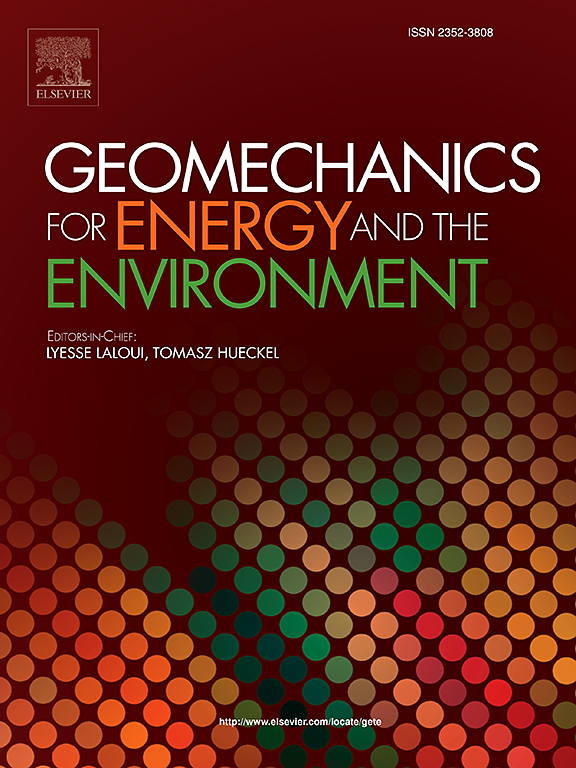Characterizing mechanical anisotropy in rocks using instrumented scratch test
IF 3.3
2区 工程技术
Q3 ENERGY & FUELS
引用次数: 0
Abstract
This study demonstrates a successful application of scratch test to characterizing geomechanical anisotropy in weakly to moderately anisotropic sedimentary rocks. Scratch tests were performed in three orthogonal directions on four sedimentary rock samples: one limestone and three shales, and the scratch-derived mechanical properties were compared to anisotropic parameters calculated from acoustic velocities. Results showed a similar pattern of anisotropy in the scratch-derived unconfined compressive strength (UCS) and fracture toughness (KIC), and velocity-derived Thomsen’s parameters. The measured values also compared well to previous studies of anisotropy in shales. The UCS and KIC for shale samples were correlated: shales with higher UCS were also characterized by higher KIC, and vice versa. The lowest values for both were observed perpendicular to bedding planes. All parameters consistently indicated that three out of four samples were transversely isotropic, and one sample exhibited more orthotropic behavior. Overall, our results indicate that scratch tests provide a simple and reliable tool for screening and potentially quantifying mechanical properties of anisotropic rocks. Compared to the majority of conventional geomechanical methods, which are destructive and require multiple directional samples, scratch test provides an opportunity to characterize mechanical anisotropy with very limited rock material and/or on a single sample.
用仪器划痕试验表征岩石力学各向异性
本研究成功地将划痕试验应用于弱至中等各向异性沉积岩的地质力学各向异性表征。对四种沉积岩样品(一种石灰岩和三种页岩)进行了三个正交方向的划痕试验,并将划痕力学特性与由声速计算的各向异性参数进行了比较。结果显示,划痕导出的无侧限抗压强度(UCS)和断裂韧性(KIC)以及速度导出的Thomsen参数具有相似的各向异性模式。测量值也与之前对页岩各向异性的研究结果相比较。页岩样品的UCS和KIC具有相关性:UCS越高的页岩,其KIC也越高,反之亦然。两者的最低值均在垂直于顺层平面处观察到。所有参数一致表明,四个样品中有三个是横向各向同性的,一个样品表现出更多的正交异性行为。总的来说,我们的研究结果表明,划痕试验为筛选和量化各向异性岩石的力学特性提供了一种简单可靠的工具。与大多数常规地质力学方法相比,划痕测试提供了一个机会,可以在非常有限的岩石材料和/或单个样品上表征力学各向异性。
本文章由计算机程序翻译,如有差异,请以英文原文为准。
求助全文
约1分钟内获得全文
求助全文
来源期刊

Geomechanics for Energy and the Environment
Earth and Planetary Sciences-Geotechnical Engineering and Engineering Geology
CiteScore
5.90
自引率
11.80%
发文量
87
期刊介绍:
The aim of the Journal is to publish research results of the highest quality and of lasting importance on the subject of geomechanics, with the focus on applications to geological energy production and storage, and the interaction of soils and rocks with the natural and engineered environment. Special attention is given to concepts and developments of new energy geotechnologies that comprise intrinsic mechanisms protecting the environment against a potential engineering induced damage, hence warranting sustainable usage of energy resources.
The scope of the journal is broad, including fundamental concepts in geomechanics and mechanics of porous media, the experiments and analysis of novel phenomena and applications. Of special interest are issues resulting from coupling of particular physics, chemistry and biology of external forcings, as well as of pore fluid/gas and minerals to the solid mechanics of the medium skeleton and pore fluid mechanics. The multi-scale and inter-scale interactions between the phenomena and the behavior representations are also of particular interest. Contributions to general theoretical approach to these issues, but of potential reference to geomechanics in its context of energy and the environment are also most welcome.
 求助内容:
求助内容: 应助结果提醒方式:
应助结果提醒方式:


